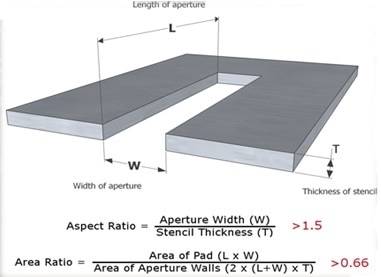Инструменты пользователя
Боковая панель
Трафареты для нанесения паяльной пасты
| http://service.laser-trafaret.ru/lazer.php | изготовление трафаретов |
| https://pcbrussia.ru/stencil/ | изготовление трафаретов |
| https://www.rezonit.ru/stencil/ | изготовление трафаретов |
| http://stencil.ru/ | изготовление трафаретов |
| https://www.rezonit.ru/stencil/stencil-storage-system/ | шкафы для трафаретов |
| https://toptradeco.ru/catalog/zapasnyie-chasti-dek/rakeli-dlya-naneseniya-payalnoj-pasty/ | ракели для паяльной пасты |
- Материал
- Размеры
- С рамкой\без рамки
- Толщины
- Многоуровневые
- Способ производства
- Электрополировка
- Nanocoating
- Финишное покрытие
- Угол стенок
- Графировка fiducial на трафарете
- Правила для апертур
- для маленьких падов
- для больших падов
- для предотвращения перемычек
- для предотвращения шариков припоя
-
- При наличии больших падов на пузе компонентов - разделять
paste maskна более мелкие области, чтобы паста не растекалась от излишка - Если via в падах - есть вероятность протекания пасты при пайке, возникновения мусора на обратной стороне и вокруг и плохой в итоге пайки
- можно не более определённого диаетра - 0.3???
- иначе надо:
- либо закрывать маской ???
- либо заполнять компаундом
- либо не наносить пасту на отверстия (предусматривать в трафарете)
- на трафарете
fiducial pointsнадо не вырезать, не не вырезать, а гравировать - тогда автомат будет хорошо сопоставлять плату и трафарет- делается отдельным gerber слоем - информация для гравирвки
WLCSP
ONSEMI
IPC−7525 provides guidelines on the design of stencils for surface mount. There are three major factors that affect the
solder paste release performance of the stencil during the printing operation:
- the area ratio and aspect ratio of the aperture;
- the sidewall design;
- the surface finish of the stencil walls.
Laser−cut stencil with complementary electro−polishing is recommended to improve solder paste release performance. Generally, the aspect ratio should be >1.5 and the area ratio >0.66.
However, in certain cases, depending ontermination size and termination pitch the aspect and area ratio may change.
Common stencil thicknesses for WLCSP are 0.100 and 0.125 (4 and 5 mils, respectively). Tapering on the stencil aperture is usually between 2 to 5°, which can be achieved by making the PCB contact side 0.025 mm larger than the squeegee side.
Additionally, curved corners for rectangular apertures promote better paste release and stencil cleaning. Reducing the stencil aperture to less than that of the board land pad is desirable to enhance the process of printing, reflow, and stencil cleaning. This minimizes the board pad and stencil opening misalignment.
NXP
Both square and round shaped apertures have been used successfully, however square shaped aperture openings provide more
consistent paste printing and transfer efficiency when compared to round openings. Corners may be rounded to prevent clogging.
- For 0.50 mm pitch WLCSP devices, 1:1 aperture to pad ratio is recommended for SnAgCu alloys.
- For 0.40 mm pitch WLCSP devices, use aperture aspect ratio of >= 0.66, with 0.25 mm x 0.25 mm square openings (25 micron corner
radius) for improved solder paste deposition repeatability.
Aperture aspect ratio is defined as the aperture opening area divided by the aperture side wall surface area.
A 0.100 mm (4-mil) thick stainless steel stencil is recommended. When these stencil design requirements conflict with other required SMT components in a mixed technology PCB assembly, a step-down stencil process may be utilized in compliance with IPC-7525 [4] design standards.


